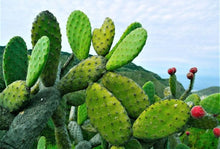
Nopal (from the Nahuatl word nohpalli [noʔˈpalːi] for the pads of the plant) is a common name in Spanish for Opuntia cacti (commonly referred to in English as prickly pear), as well as for its pads.
There are approximately one hundred and fourteen known species endemic to Mexico, where the plant is a common ingredient in numerous Mexican cuisine dishes. The nopal pads can be eaten raw or cooked, used in marmalades, soups, stews and salads, as well as being used for traditional medicine or as fodder for animals. Farmed nopales are most often of the species Opuntia ficus-indica or Opuntia matudae although the pads of almost all Opuntia species are edible. The other part of the nopal cactus that is edible is the fruit called the tuna in Spanish, and the "prickly pear" in English.
Nopales are generally sold fresh in Mexico, cleaned of spines, and sliced to the customer's desire on the spot. They can also be found canned or bottled as nopalitos, and less often dried, especially for export. Cut into slices or diced into cubes, nopales have a light, slightly tart flavor, like green beans, and a crisp, mucilaginous texture. In most recipes, the mucilaginous liquid they contain is included in the cooking. They are at their most tender and juicy in the spring.
Nopales are most commonly used in Mexican cuisine in dishes such as huevos con nopales "eggs with nopal", carne con nopales "meat with nopal", tacos de nopales, in salads with tomato, onion, and queso panela (panela cheese), or simply on their own as a side vegetable. Nopales have also grown to be an important ingredient in New Mexican cuisine[3] and in Tejano culture of Texas.
~Pad/cutting
______PLEASE BE AWARE OF YOUR WEATHER BEFORE ORDERING___
*Not responsible for lost or damaged packages due to shipping companies handling.
We will send you info to file a claim.













